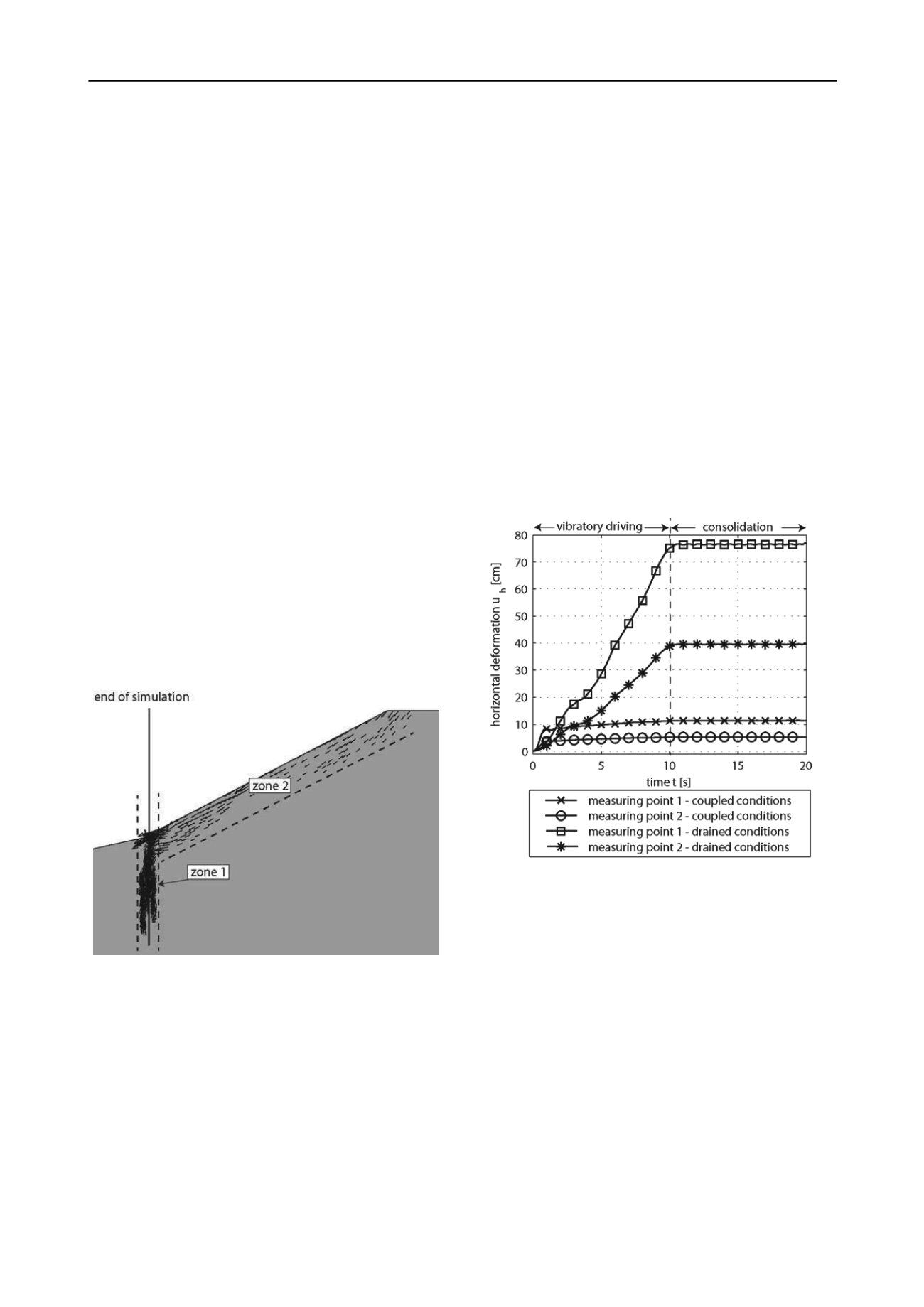
721
Technical Committee 103 /
Comité technique 103
4 RESULTS
Considering an elastic pile driving guide as in reality was not
possible in the numerical simulation due to numerical
instabilities of the analysis caused by too many interactions in
the model. For simplification the investigation of the presented
case of damage is done by studying two limit cases:
1. Free-riding vibratory driving without a pile driving guide
2. Assumption of a rigid pile driving guide
The behavior of the real pile driving guide is to be expected
between these two limit cases. Furthermore the deformations
and reaction forces of the sheet pile obtained by an analysis
with coupled conditions (
k
f
= 1.0·10
-4
m/s) are compared to
results obtained by assuming fully drained. The difference and
the error done by assuming fully drained conditions can be
shown.
4.1
Deformation mechanism
Due to the vibratory driving a cyclic shearing of the soil and a
rearrangement of the soil particles with the result of soil
compaction occurs in the near-field of the sheet pile. The
deformation mechanism of the embankment shown in Figure 3
can be divided into two zones. In the first zone, in the near-field
of the sheet pile, the soil is moving in approximately vertical
direction due to soil compaction with the result of surface
settlements. In a second zone at the surface of the embankment
a layer of soil is sliding down the embankment into the
compacted near-field and pushes against the installed sheet pile.
This is the main reason of the observed horizontal deformations
of the sheet pile wall. The presented deformation mechanism is
in accordance to results of fully drained conditions of the soil
(Hamann and Grabe 2012b).
4.2
Horizontal deformation of the sheet pile
The evolution of the deformation of the sheet pile with respect
to time are shown in Figure 4 for the case of a free-riding
vibratory driving with coupled and fully drained conditions. In
case of a rigid pile driving guide the deformations are smaller
than 5 mm and thus not illustrated. The great difference
regarding deformations of coupled and fully drained conditions
is caused by the velocity of soil compaction. In case of fully
drained conditions no excess pore water pressure and thus no
resistance against a reduction of the void volume can develop.
Hence the whole deformation mechanism of the embankment
caused by soil compaction, consisting of a layer of soil sliding
down the embankment and pushing against the sheet pile,
develops faster as for coupled conditions. Since no asymptotic
behavior of the evolution of the deformation can be seen in both
cases, a further increase of the deformations can be assumed in
case of a longer simulation time. A possible limit of the
deformation in case of a longer simulation time will be reached
faster with a drained analysis.
In case of coupled conditions a very fast increase of the
deformation after the beginning of the vibratory driving occurs
due to soil liquefaction in the near-field of the pile. Afterwards
the deformations are increasing slower, since the soil is
compacted slower due to the development of excess pore water
pressure. The movement of the layer of soil sliding down the
embankment and thus the deformation of the sheet pile is
slower. At the end of simulation horizontal deformations of
u
h1
= 11.5 cm at measuring point 1 and
u
h2
= 5.5 cm at measuring
point 2 are calculated.
It has to be considered, that the deformations illustrated in
Figure 4 are calculated for the case of a free-riding vibratory
driving and that restrictions resulting of a two-dimensional
analysis have to be observed. In reality the single double piles
are installed one by another and the used pile driving guide
which is fixed at the already installed piles can also drift
laterally due to the installation process.
4.3
Reaction forces of the pile driving guide
The evolution of the horizontal reaction forces of a rigid pile
driving guide with respect to time is given in Figure 5 for the
case of coupled and fully drained conditions. The direction of
action of the reaction forces is depicted in Figure 1. Due to the
cyclic shearing of the soil caused by the vibratory driving a very
fast decrease of the horizontal and vertical stress state in the
near-field of the sheet pile occurs (Hamann and Grabe 2012b).
Furthermore a layer of soil is sliding down the embankment and
pushes against the sheet pile, which leads to a sided loading of
the pile, see Figure 3. Thus a fast increase of the reaction forces
occurs at the beginning of the vibratory driving in both cases.
In case of fully drained conditions a further increase of the
reaction forces can be observed because the layer of soil sliding
into the compacted near-field and thus the sided loading of the
pile becomes bigger with progressing soil compaction.
In case of coupled conditions the reaction forces decrease after
the initial increase. The evolution of the reaction forces is the
result of a complex interaction of a sided increase of excess
Figure 3. Deformation mechanism of the embankment for
coupled conditions of the soil, free-riding vibratory driving.
Figure 4. Evolution of horizontal deformation of measuring point 1 and
2, comparison of coupled (
k
f
= 1.0·10
-4
m/s) and fully drained
conditions of the soil, free-riding vibratory driving.


